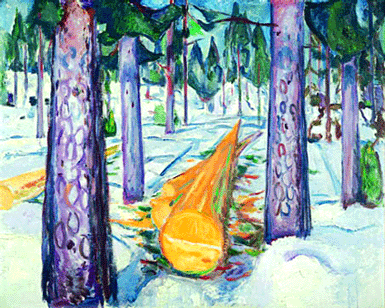An exhibition of Edvard Munch sidesteps his best later work
The first Edvard Munch retrospective in America in the past 30 years is a big disappointment, but it’s not the artist’s fault. The obligation to provide a narrative shape that highlights the genuine achievements of an important artist’s career has been neglected here.
The works have been hung insensitively. An institution devoted to the Modernist discourse might have attempted to bring out how Munch’s pictorial language underlined his expressionist themes, for example, and then followed this through his career. It would have been fruitful to have treated Munch like a painter instead of an illustrator of modern angst. The show is content to tell the familiar story of his life in his art.
This is fine in the first half of the show. All of Munch’s emblematic images—“The Dance of Life,” “Madonna,” a woodcut of “The Scream”—bring the audience inside this drama. Seeing the actual works, one picks up on the artist’s impatience and how that seems to propel the rhythms that unite the gesture and flow of the figures with their surroundings. In “The Sick Child,” Munch broke pictorial composure, scratching into the canvas, like he didn’t give a damn about the distance between his feelings and his motif any longer. Bridging this gap, the picture became both a receptacle for the artist’s feelings and a barometer of responses in others.
In “The Kiss,” passion enters the room as if from the adjacent windswept curtain. In subsequent works, the imprint of the body’s presence is a container of subjectivity—it slouches and grasps its way through the rectangle as it does through life. The transparency of means—paint applied in as undisguised a manner as possible, patches of exposed raw canvas—clarifies and enhances the awful sloppiness of emotions. Grief, disappointment, and wretchedness rumble through the pictures, all “Dances of Life.”
Munch paints murk that somehow works—steel grays, dark roses, jaundice yellows; he is able to choose colors that seem to translate from hospital smells. Even the landscapes reek with this pollution of mood. This is a depressive expressionism, but still full of remarkable wit, intelligence, and, at moments, hilarity. He even paints himself as Christ on the cross. Munch is a spiritual forbear of Rainer Werner Fassbinder and Leonard Cohen, tender ironists all.
The trouble comes after this famous period, when the exhibition constructs Munch as an artist who has, according to the institution, “moved into more traditional imagery.” While it is true that he took many commissions, the work that he did for what appear to be his own reasons shows that he became a more inventive painter. This was evident in “After the Scream, ” an exhibition seen at the High Museum in Atlanta in 2002. One discovered that the explicit psychology of the earlier work was subsumed under an austere, light-filled but rangy battery of painting marks. Images of horses in the snow, workmen building, figures in gardens all seemed to rise from the muscles of the earth. Some of this late work is in this exhibit, but it is tucked in at the edges, hemmed in.
There is a long wall of mostly unilluminating portraits, including a weak one of Nietzche, which is only of biographical interest. It was felt necessary to line up a series of self-portraits lest the point be missed that the artist sometimes scrutinized himself. This exhibition is a remarkable simulation of the experience of thumbing through the little Abrams book on Munch that was published 40 years ago, but it neglects bringing any new access to his continuing relevance.
gaycitynews.com



































